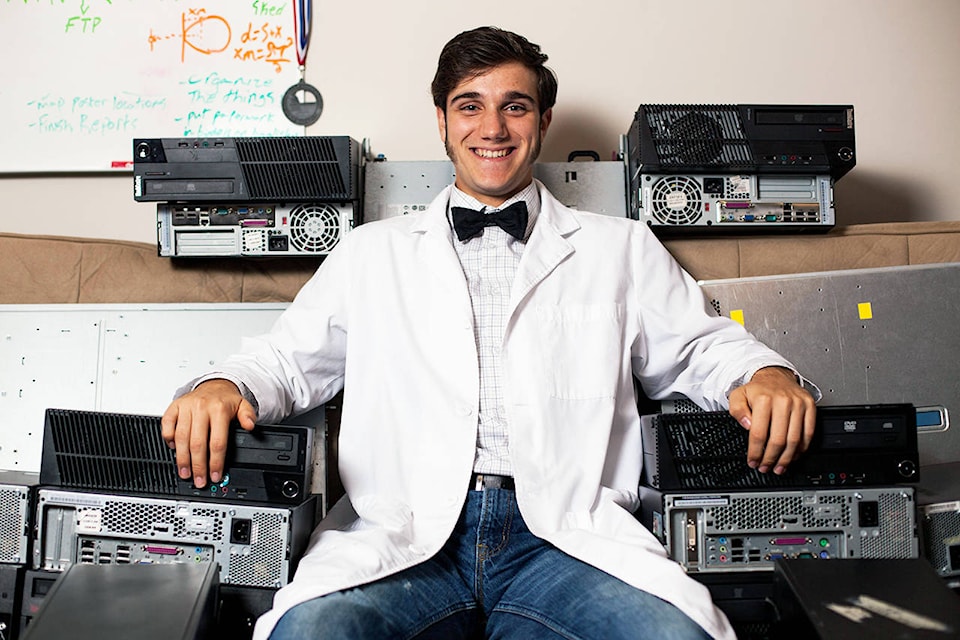Tim Collins/News staff
Triston Line has always had an interest in technology.
He was the leader of the Edward Milne Community School (EMCS) Robotics Team and the head theater technician at EMCS. He also worked for Apple, fixing i Macs, Macbooks and other Apple products.
He’s now moved on to studies at Camosun College where he is a computer network electronics technician student.
While it doesn’t come as a surprise that Line has a few computers of his own, the actual number of those computers has, at times, raised a few eyebrows. By salvaging discarded equipment from School Division 62, and rescuing others from a series of companies and individuals intent upon upgrading their systems, Line has accumulated more than 60 computers in his home, ranging from standard desktops to industrial server blades.
Oft times, Line has simply refurbished donated computers and then re-donated them to individuals who can’t afford a computer.
But recently, his computers have been fulfilling a far more unique, and some may say, valuable, purpose.
About two year ago, Line’s godfather, who works for a bio-tech company in Washington State, told Line about how the medical field is often in need of computational power. Line approached Washington State University, and he started out helping them with an on-going research project by using the power of his multiple computers to crunch data.
When that project was completed, the university suggested that Line contact IBM who gave him set-up instructions and programs to make his system more efficient.
True to form, Line streamlined those programs and, in conjunction with the University of California, and made them applicable to both Linux and Windows operating systems.
With that done, Line made the computational power of his computer array available to researchers at the Broad Institute of the Massachusetts Institute of Technology, the University of California San Diego, Simon’s Foundation Flatiron Institute, the Massachusetts General Hospital and Harvard.
They took up his offer and now provide Line with raw research data and he uses his computers to validate that data and return it to the researchers.
It’s not a new concept, of course, as there are about three quarters of a million private computer owners world-wide performing this kind of work. But while most of these volunteers may give up some of their personal computer’s time, Line’s extensive array of salvaged units are a step above the average. Recent data shows him in the top .39 percentile of all volunteer research processors around the globe.
While it may be hard to wrap one’s head around just what Line is accomplishing, a few sample facts and figures may be instructive.
In a project to map cancer cells for Princess Margaret Cancer Center, Line has contributed the equivalent to 36 years of processing time to the project. That effort resulted in completing 67,592 tasks for the project.
For a project to cure Ebola, Line’s computers have supplied five years of processing time, completing 30, 714 tasks.
And the list goes on.
Line’s computers have helped with HIV/AIDs research, finding a cure for the ZIKA virus, the search for a cure for childhood cancer and more.
“I just think that it’s important to realize that we don’t need to be discarding all this e-waste every year. Not only is it bad for the environment, it’s a waste of the good that these computers could be doing if only people like me put a little time into putting them to work on these kind of projects,” said Line.
Remarkably, Line said he’s intent on keeping technology as a side interest and, after graduating from Camosun, he intends to pursue degrees in geography and urban planning.
“It’s possible that, at some point in the future, i find a way of integrating technology with urban planning and find a better way to create our living spaces. That would be very neat, I think,” said Line.
For now, though, he is content to help out medical research and he said he hopes that the world takes notice and discovers that Sooke is not just some backwoods, small town with pretty scenery, but a place of smart people and awesome science as well.
